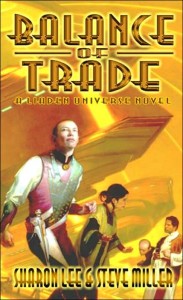
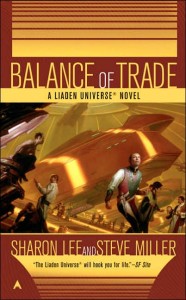 The latest offering from Lee and Miller, though set quite firmly in the Liaden setting, is actually a standalone, the first Liaden novel to date not to feature the influential and far-roving members of Clan Korval. Instead, we’re introduced to Terran would-be trader Jethri Gobelyn, whose family owns a number of trading ships, including the Gobelyn’s Market. His relationship with his family isn’t as secure as it could be; ever since the death of his father, his mother and Captain of the Gobelyn’s Market has become increasingly distant. When Jethri discovers he’s been apprenticed to another ship, he resists the initial idea of leaving the only home he’s ever known. However, an investment gone sour opens up new doors of opportunity, and before he fully understands the consequences, he’s joined the crew of the Liaden ship Elthoria under the supervision of Master Trader Norn van’Deelin, who sees in Jethri a way to bridge the differences between Liadens and Terrans. Now Jethri is continually tested, circumstances dictating he learn a whole host of new customs as he interacts with a people who place an inordinate amount of importance upon honor, reputations, dignity, and propriety. Where one wrong move, or even an improper bow can affect the directions of entire clans, he can’t afford a single misstep. But if he watches his step, he could make a fortune. If only he can overcome the prejudice many Liadens feel towards Terrans, and unravel the mystery left in the wake of his father’s death years ago….
The latest offering from Lee and Miller, though set quite firmly in the Liaden setting, is actually a standalone, the first Liaden novel to date not to feature the influential and far-roving members of Clan Korval. Instead, we’re introduced to Terran would-be trader Jethri Gobelyn, whose family owns a number of trading ships, including the Gobelyn’s Market. His relationship with his family isn’t as secure as it could be; ever since the death of his father, his mother and Captain of the Gobelyn’s Market has become increasingly distant. When Jethri discovers he’s been apprenticed to another ship, he resists the initial idea of leaving the only home he’s ever known. However, an investment gone sour opens up new doors of opportunity, and before he fully understands the consequences, he’s joined the crew of the Liaden ship Elthoria under the supervision of Master Trader Norn van’Deelin, who sees in Jethri a way to bridge the differences between Liadens and Terrans. Now Jethri is continually tested, circumstances dictating he learn a whole host of new customs as he interacts with a people who place an inordinate amount of importance upon honor, reputations, dignity, and propriety. Where one wrong move, or even an improper bow can affect the directions of entire clans, he can’t afford a single misstep. But if he watches his step, he could make a fortune. If only he can overcome the prejudice many Liadens feel towards Terrans, and unravel the mystery left in the wake of his father’s death years ago….
I love the Liaden books. While Balance of Trade isn’t my favorite (that honor still goes to Scout’s Progress), there’s no denying that Jethri Gobelyn is a most likeable character, the sort you can’t help but want to succeed. It could almost be argued that he’s too perfect, given his natural ability to interact on a socially acceptable level with even the most narrow-minded of Liadens, but luckily, his flaws come out when he’s forced to embrace radical change in his life. I also love the Liadens themselves; their concept of melant’i, a code of honor and conduct which dictates their standing in social, professional, and emotional interactions, remains one of my favorite aspects of the Liaden Universe.
Frankly, the only thing I find missing in Balance of Trade is the underlying (or more overt) romance which has characterized the other Liaden stories, something I consider to be one of Lee and Miller’s strengths. I hope we’ll get to see more of Jethri Gobelyn, as his story is far from over. Balance of Trade is a low-key space opera that relies heavily on characterization, multilayered plotting, and social conflicts, rather than on violence and blasters. It’s actually a perfect introduction to the Liaden Universe, and I recommend it to longtime fans and newcomers alike.
 Ensign Paul Sinclair has just been assigned to the USS Michaelson, his first posting as an officer. Armed with several years of Academy training and specialized schooling, he’s surprised when his lone legal course qualifies him to be the ship’s legal officer, a role he’s none too eager to play. He’s got enough on his plate as it is, trying to get the hang of things aboard ship in the Navy of the future, without trying to worry out legal ramifications for complex situations. And a very complex situation’s been dropped into his lap, when the Michaelson is ordered to patrol American interests in space, and to enforce the sovereignty of said interests, doing whatever it takes. With disturbingly vague orders comes a disturbingly vague ship’s captain, Pete Wakeman, whose mental stability seems to be in question.
Ensign Paul Sinclair has just been assigned to the USS Michaelson, his first posting as an officer. Armed with several years of Academy training and specialized schooling, he’s surprised when his lone legal course qualifies him to be the ship’s legal officer, a role he’s none too eager to play. He’s got enough on his plate as it is, trying to get the hang of things aboard ship in the Navy of the future, without trying to worry out legal ramifications for complex situations. And a very complex situation’s been dropped into his lap, when the Michaelson is ordered to patrol American interests in space, and to enforce the sovereignty of said interests, doing whatever it takes. With disturbingly vague orders comes a disturbingly vague ship’s captain, Pete Wakeman, whose mental stability seems to be in question.
After the unthinkable occurs, and the Michaelson fires upon, and destroys a civilian research ship belonging to another country, Paul is forced to put everything he knows and believes in into perspective. The Michaelson is recalled home, Wakeman to stand trial for his actions as captain, and Ensign Sinclair must decide what version of the truth to go with. His testimony could do more than help the captain he doesn’t trust, it could make or break his career as well. But going with his heart may cost him all of that.
The characters, situations, and moral dilemna all reminded me strongly of a Heinlein juvenile, such as Space Cadet, or even William Forschten’s more recent Star Voyager Academy series. It’s almost deceptively simple on the surface, but the further you dig, the more there is to consider. Clearly the first in a new series, A Just Determination is proof that Hemry’s an author to keep an eye on.
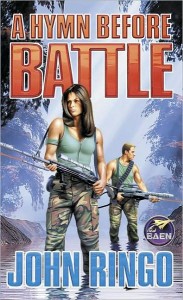 There has been no shortage of books dealing with “First Contact” between humanity and extra-terrestrial races, and the results thereof. In his first novel, newcomer John Ringo skips all of the anticipation and wondering, and gets right down to business, as in the year 2001, we learn that we’re not alone. In fact, there are a fair number of alien races out there, and they need our help.
There has been no shortage of books dealing with “First Contact” between humanity and extra-terrestrial races, and the results thereof. In his first novel, newcomer John Ringo skips all of the anticipation and wondering, and gets right down to business, as in the year 2001, we learn that we’re not alone. In fact, there are a fair number of alien races out there, and they need our help.
The battles lines are drawn right up front. The “good guys” are the Galactic Federation, and they offer to share information, technology, and the stars with us for a small price: help fight their interstellar war against the implacable and unending hordes of the Poseen, a race of near-moronic drones led by fierce, intelligent God-Kings. We’re free to refuse the offer and mind our own business, but the war will come to us anyway. Earth is in the Poseen’s path. We fight now, or we die later. And so Earth goes to war. Using alien technology, we design and build mighty suits of combat armor, all the while racing against the clock. We call up our veterans, arm the military, and prepare for all-out war. Millions are drafted or recalled into service, including Lt. Michael O’Neal, Sergeant Major Jacob Mosovich, and Master Gunnery Sergeant Earnest Pappas. While millions will be involved, it’s these three who provide the pivotal and most telling viewpoints, as they experience the war on three different fronts.
For Pappas, it’s the near-impossible job of whipped untried rookies and new soldiers into fighting condition, hampered by short supplies, insufficient information, and mutiny in the ranks. Unyielding, uncompromising, and as tough as any the Marines have ever turned out, he’ll be the only hope for survival some of these soldiers have. For Mosovich, it’s a return to a dirty kind of war, a do or die mission of reconnaissance on a far-distant planet, where the only rules are to survive, don’t get caught, and learn as much as possible about the enemy while there’s still time. O’Neal has the hardest job of all: help design the all-important armored battle suits that could turn the tide against the Poseen, and accompany the first contingent of Armored Combat Suit troops into space. They’re undertrained, undermanned, and woefully unprepared for the chaos and carnage.
With mutiny, insurrection and rioting at home, and mass slaughter abroad, it looks like Earth’s chances may be limited. They’re fighting a two-sided war, hampered more than helped by the “cooperation” of their so-called allies, races of bureaucrats and cowards. Technology is only as good as the user, and only as reliable as the supplier. Inexperience on the one hand and short supply on the other mean that the Earth forces will have to fall back on their best weapons: improvisation and ingenuity. This is all-out war, and a great many people won’t be coming home. Ultimately, even if we do survive and succeed on the initial battlefields, it’s just the beginning of a long and messy campaign. What will happen when the Poseen reach Earth?
As could be expected, A Hymn Before Battle is just the first book in the series. The sequel, Gust Front, is already out in stores. While this book does come to a definite conclusion, there’s more than enough room for much more story along each of the various threads and plots that make up the whole. The writing is intelligent and crisp, the battle scenes appropriately visceral and even over-the-top, as befits a war told on such a scale, and the characters memorable.
Where the book falls down, unfortunately, is in keeping the non-military reader properly interested and informed. Ringo demonstrates his own military knowledge, tossing around the jargon with very little restraint, for that authentic feel. While the characters are wonderful to follow, it’s occasionally difficult to keep up with the abbreviations and acronyms, and the not-always-explained distinctions between various military units. This is a first-rate military science fiction story with a lot of potential, but casual readers should thus been warned. Keeping track of some elements of the story may require a commitment. The payoff, however, is an exciting story reminiscent of Starship Troopers, with a 21st century eye towards widescreen action. John Ringo is an author to keep an eye on.
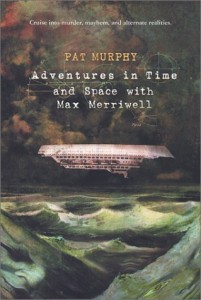 Identity and metafiction come head-to-head in this complex capstone to an audacious literary experiment perpetrated by Pat Murphy in this book. In two previous books, Wild Angel and There and Back Again, she laid down the groundwork for the concept of multiple layers of pseudonyms; now she brings it all together in a boundaries-crossing quantum-inspired mystery. Author Max Merriwell, himself one of Pat Murphy’s pseudonyms, is on his yearly cruise while he works on several books (namely, the two named above). However, when Mary Maxwell and Weldon Merrimax, his –own- pseudonyms come to life aboard the ship, it’s up to Max and his new friend, Susan Galina (and her friend, Pat Murphy), to unravel the mystery before anyone gets hurt. As the ship travels into the Bermuda Triangle, things get seriously weird, lines blurring and genres breaking down. Before it’s all over, Max’s nature will come into question, and reality itself will be thrown for a loop.
Identity and metafiction come head-to-head in this complex capstone to an audacious literary experiment perpetrated by Pat Murphy in this book. In two previous books, Wild Angel and There and Back Again, she laid down the groundwork for the concept of multiple layers of pseudonyms; now she brings it all together in a boundaries-crossing quantum-inspired mystery. Author Max Merriwell, himself one of Pat Murphy’s pseudonyms, is on his yearly cruise while he works on several books (namely, the two named above). However, when Mary Maxwell and Weldon Merrimax, his –own- pseudonyms come to life aboard the ship, it’s up to Max and his new friend, Susan Galina (and her friend, Pat Murphy), to unravel the mystery before anyone gets hurt. As the ship travels into the Bermuda Triangle, things get seriously weird, lines blurring and genres breaking down. Before it’s all over, Max’s nature will come into question, and reality itself will be thrown for a loop.
This isn’t an easy book to read, or a simple concept to follow. Rather, it’s quite daring, both clever and challenging. Taken in concert with the previous books, it puts a whole new spin on what can and can’t be done with the genre, and the nature of identity and perception versus reality.
 Piper Pied, aspiring writer, has just received the surprise of her lifetime. Her grandmother, a woman who she hadn’t even seen in six years, has passed away. At the funeral, Piper’s relatives conspire against her, manipulating her into fulfilling a very specific term of Grandma Dickerson’s will. As a result, Piper inherits her grandmother’s Victorian home, located at the very edges of a Colorado suburb. A beautiful house, it’s filled with the books and magazines and remnants of Grandma Dickerson’s eccentric collecting habits. It has a lovely view from the front door, and an even better view from the back door. In fact, the view from the back door is out of this world. Literally. In fact, it’s a portal to the land of Fairy, a dimension inhabited by creatures of our imagination and scripted by our popular literature.
Piper Pied, aspiring writer, has just received the surprise of her lifetime. Her grandmother, a woman who she hadn’t even seen in six years, has passed away. At the funeral, Piper’s relatives conspire against her, manipulating her into fulfilling a very specific term of Grandma Dickerson’s will. As a result, Piper inherits her grandmother’s Victorian home, located at the very edges of a Colorado suburb. A beautiful house, it’s filled with the books and magazines and remnants of Grandma Dickerson’s eccentric collecting habits. It has a lovely view from the front door, and an even better view from the back door. In fact, the view from the back door is out of this world. Literally. In fact, it’s a portal to the land of Fairy, a dimension inhabited by creatures of our imagination and scripted by our popular literature.
Thus, when Piper goes to explore the world outside her door, she discovers three very strange, very stereotypical creatures, one of which turns up in her own kitchen.
Aelvarim is a gorgeous elf, Larkingtower is a reclusive and misogynistic wizard, and Malroux is a charming, albeit grumpy dwarf. Not only do they represent certain archetypal figures found in “classic” fantasy, but they also fit the male trinity of youth, father figure, and grandfather figure. And none of them are particularly satisfied with their roles in life. That’s not the problem. Under normal circumstances, Piper might even be able to deal with the new weirdness in her life, balancing it with her own writing career and a part-time job in a local bookstore. These aren’t normal circumstances.
Aelvarim is convinced to a fault that Grandma Dickerson was murdered, and before long he has Piper aiding him in a search for clues, for the killer, and for a manuscript supposedly written by Piper’s grandmother before she died. If that weren’t enough, holes in reality are beginning to swallow Fairy and Earth, piecemeal. Are these events connected? And how can Piper solve the first and stop the second? If she can’t, reality itself will cease to exist. Piper will have to embrace her own inner power, accept her role in the story, and even tap into the magic of creativity to rewrite the ending, if she wants things to work out happily ever after, or even just happily for a while.
Eccentric Circles is sly and intelligent, commenting on the power of the imagination, suggesting that our subconscious influences not just the world around us but other worlds entirely, speculating on the symbiotic relationship of the mundane and the otherworldly. Rebecca Lickiss reimagines Tolkien as a shaper of worlds, and popular literature as a catalyst for cultural change, and does so with a keen sense of story and characterization that makes the book rather too short for the immense potential suggested as a result. She’s opened an interesting can of literary worms with this, her debut novel, and hopefully she’ll use them as bait for subsequent stories. I’m looking forward to her next release, in the hopes that it’ll be longer, and more complex, as I think she’s got a lot of as-yet untapped potential. Give this one a perusal.
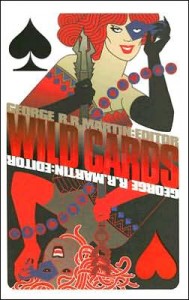 After a significant hiatus, the popular Wild Cards series of shared-world anthologies and novels returns, with an all-new collection of tales drawn from the sixty-year history of a world gone mad. In 1946, an alien virus is released over New York City, killing the vast majority of those it infects, and transforming the rest either into hideously deformed beings (Jokers), or super powered people (Aces). However, a third category has long fallen between the cracks: those whose deformities or powers are so mild as to make them near-inconsequential, people known as Deuces. For the first time, they’re getting the spotlight, as some of the authors best associated with the Wild Cards series reveal the cards up their sleeves.
After a significant hiatus, the popular Wild Cards series of shared-world anthologies and novels returns, with an all-new collection of tales drawn from the sixty-year history of a world gone mad. In 1946, an alien virus is released over New York City, killing the vast majority of those it infects, and transforming the rest either into hideously deformed beings (Jokers), or super powered people (Aces). However, a third category has long fallen between the cracks: those whose deformities or powers are so mild as to make them near-inconsequential, people known as Deuces. For the first time, they’re getting the spotlight, as some of the authors best associated with the Wild Cards series reveal the cards up their sleeves.
Michael Cassutt tells the untold story of the first men on the mood, John J. Miller looks at a World Series that never was, Walton Simons looks at the great New York blackout of 1977, Melinda M. Snodgrass approaches the subject of a centaur in Hollywood, Daniel Abraham addresses the matter of faith in a world gone insane, Steven Leigh takes us to Ireland for a look at a modern-day leper colony, and Kevin Andrew Murphy asks what happens what you lose the one thing your powers depend upon.
For those who were already fans of the Wild Cards series, this will be a welcome treat, delivering the same complex stories as before (with a more upbeat tone to them!). For newcomers, this is the perfect jumping-on point, as it’s kept relatively free from past continuity, and explains the premise succinctly enough.
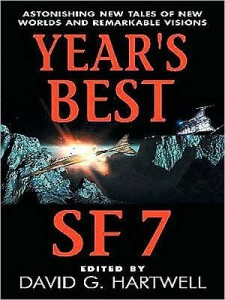 It’s time again for David Hartwell’s annual roundup of what he considers to be the best science fiction of the year, collected from various sources. It’s a fairly impressive selection, boasting stories by Michael Swanwick, Terry Bisson, Nancy Kress, James Morrow, James Patrick Kelly, Gene Wolfe, and more. Many of the stories were first published in magazines such as Analog and Asimov’s, though a fair number first appeared in the original anthology, Redshift. This is indeed a collection of excellent stories, ones deserving of recognition, and it would serve well as a sampler for the genre.
It’s time again for David Hartwell’s annual roundup of what he considers to be the best science fiction of the year, collected from various sources. It’s a fairly impressive selection, boasting stories by Michael Swanwick, Terry Bisson, Nancy Kress, James Morrow, James Patrick Kelly, Gene Wolfe, and more. Many of the stories were first published in magazines such as Analog and Asimov’s, though a fair number first appeared in the original anthology, Redshift. This is indeed a collection of excellent stories, ones deserving of recognition, and it would serve well as a sampler for the genre.
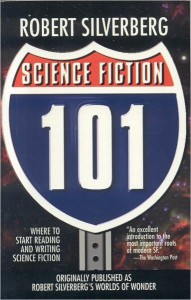 Originally published in 1987 as *Robert Silverberg’s Worlds of Wonder*, this handsome book has been rereleased under the new title of *Science Fiction 101: Where To Start*, and proves that even with a facelift, it hasn’t aged at all. It’s still as fascinating and informative as ever, and just as relevant for a new generation of science fiction readers and writers. Part essays, part memoirs, and part anthology, it manages to blend the various elements into a seamless whole.
Originally published in 1987 as *Robert Silverberg’s Worlds of Wonder*, this handsome book has been rereleased under the new title of *Science Fiction 101: Where To Start*, and proves that even with a facelift, it hasn’t aged at all. It’s still as fascinating and informative as ever, and just as relevant for a new generation of science fiction readers and writers. Part essays, part memoirs, and part anthology, it manages to blend the various elements into a seamless whole.
Essentially, what this is, is Silverberg’s commentary on what exactly makes science fiction. What invoked his sense of wonder, suspended his disbelief, and sparked his imagination. What stands out as the finest examples of the genre, with an eye towards their heuristic value. What can we take away from studying these stories, and apply to our own reading experience, or in some cases, to our own writing? He lays it out in a series of crisp, accessible essays following each of his choices. He outlines the aspects that brought him to each story, and how they define science fiction itself, aspects that include the underlying speculative concept, and the imposition of a sense of limitations within the assumption of the story. Not every story is what we’d consider a classic, but all bear the traits that made Silverberg, long considered a master of the science fiction field, choose them as examples.
For instance, C.M. Kornbluth’s “Little Black Bag” contrasts seeming utopia and dystopia, explores the wonders of technology, employs logical aspects of time travel, and the ultimate degeneration of intelligence when our own tools get too smart for us, all while playing with morality and sharp characterization. Philip K. Dick’s brilliant “Colony” demonstrates the blending of science fiction and horror with a true understanding of what makes the alien so terrifying, and ends with his traditional subtlety, leaving the exact nature of the finale to the imagination where it belongs.
Alfred Bester’s “Fondly Fahrenheit” is chilling, a psychological tale of a man, a android, and a murderer that only comes out when it gets too hot. Who’s insane, the man or his android, and what’s really going on? The rapidly shifting perspective and tense usage (sporting sentences like “He doesn’t know which of us I am these days, but they know one truth”) both jostle the reader and keep the characters of the story at uncomfortable arm’s length. Breaking grammatical rules like very few ever can, Bester’s story is an example of what a skilled writer can accomplish with the genre. However, Robert Sheckley’s “The Monsters” takes things to an even more alien perspective, where humans are the true indecipherable, unfathomable, unpredictable outsider. What makes perfect sense to the “alien” protagonists of this story is inconceivable, even barbaric to human standards, and culturual rifts abound as a result. Life Swift did when he took Gulliver outside of his native civilization and exposed him to other lands, so does Sheckley do here, presenting an alternative system of morality in such a way that we have to consider how we view our own world.
These are only four of the thirteen stories which Silverberg has collected, including authors such as Frederick Pohl, Jack Vance, James Blish, and Damon Knight. Adding his own essays and experiences to the mix, Silverberg thus presents an eclectic but invaluable collection that stretches the bounaries of the genre and allows us access to the mind of a man who’s won a combined nine Nebula and Hugo awards. Whether you’re just a fan who likes stories with a challenge, or someone actively trying to get a better feel for science fiction, this is a collection worth reading.
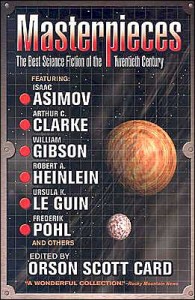 This anthology is worth noting for its ambitious claim of collecting the best science fiction of the 20th Century. Whether or not that’s entirely accurate, it does put together a pretty impressive list of stories to represent the field. From the “Golden Age” we have stories like “All You Zombies—“ by Heinlein, and Arthur C. Clarke’s “The Nine Billion Names of God.” From the “New Wave”, ““Repent, Harlequin!” Said the Ticktockman” by Harlan Ellison, and “Inconstant Moon” by Larry Niven. From the “Media Generation,” Lisa Goldstein’s “Tourists” and Terry Bisson’s “Bears Discover Fire.” These are only a few of over two dozen stories representing three eras of literary adventure and exploration. Is it the best? That’s always subjective. It’s certainly a collection of great stories, many of them classics, and well worth reading.
This anthology is worth noting for its ambitious claim of collecting the best science fiction of the 20th Century. Whether or not that’s entirely accurate, it does put together a pretty impressive list of stories to represent the field. From the “Golden Age” we have stories like “All You Zombies—“ by Heinlein, and Arthur C. Clarke’s “The Nine Billion Names of God.” From the “New Wave”, ““Repent, Harlequin!” Said the Ticktockman” by Harlan Ellison, and “Inconstant Moon” by Larry Niven. From the “Media Generation,” Lisa Goldstein’s “Tourists” and Terry Bisson’s “Bears Discover Fire.” These are only a few of over two dozen stories representing three eras of literary adventure and exploration. Is it the best? That’s always subjective. It’s certainly a collection of great stories, many of them classics, and well worth reading.
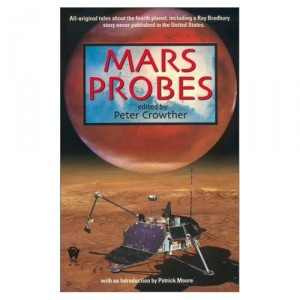 In this all-new anthology of science fiction stories inspired by Mars, some of today’s best authors take a stab at the Red Planet. Included are works by Michael Moorcock, Gene Wolfe, Scott Edelman, Alastair Reynolds, Ray Bradbury, Allen Steele, and more. While the stories are all entertaining, a few do stand out, such as Allen Steele’s “A Walk Across Mars,” in which the true story of the first Mars mission is finally revealed. The character twist that arrives near the end is so simple, yet so unexpected, as to floor the reader. Mike Resnick and M. Shayne Bell deliver a hilarious parody of the John Carter books in “Flower Children of Mars,” and Alastair Reynold’s “The Real Story” looks at another variation on whatever happened to the first man on Mars. This is an enjoyable anthology, doing justice to the topic at hand.
In this all-new anthology of science fiction stories inspired by Mars, some of today’s best authors take a stab at the Red Planet. Included are works by Michael Moorcock, Gene Wolfe, Scott Edelman, Alastair Reynolds, Ray Bradbury, Allen Steele, and more. While the stories are all entertaining, a few do stand out, such as Allen Steele’s “A Walk Across Mars,” in which the true story of the first Mars mission is finally revealed. The character twist that arrives near the end is so simple, yet so unexpected, as to floor the reader. Mike Resnick and M. Shayne Bell deliver a hilarious parody of the John Carter books in “Flower Children of Mars,” and Alastair Reynold’s “The Real Story” looks at another variation on whatever happened to the first man on Mars. This is an enjoyable anthology, doing justice to the topic at hand.
